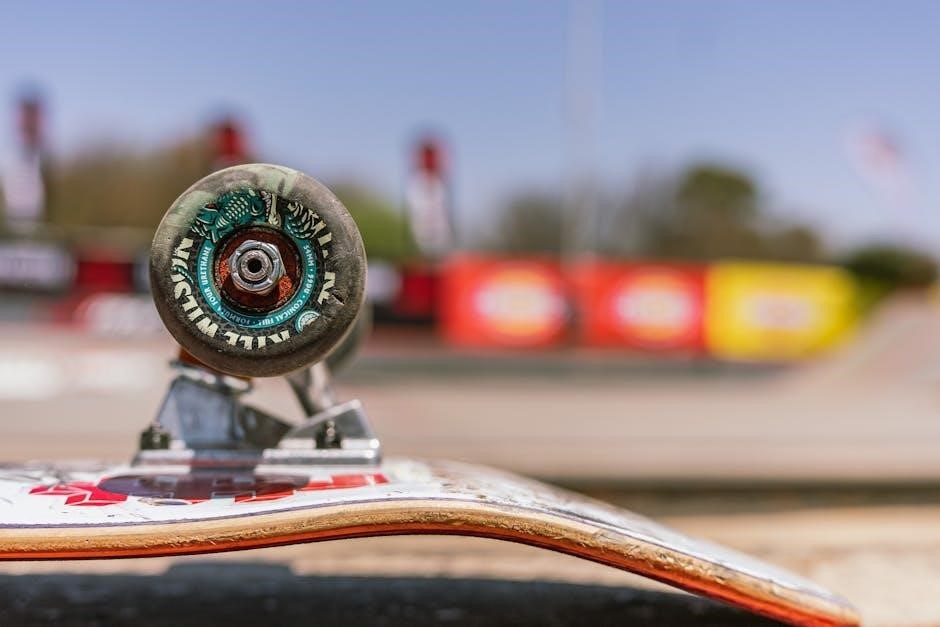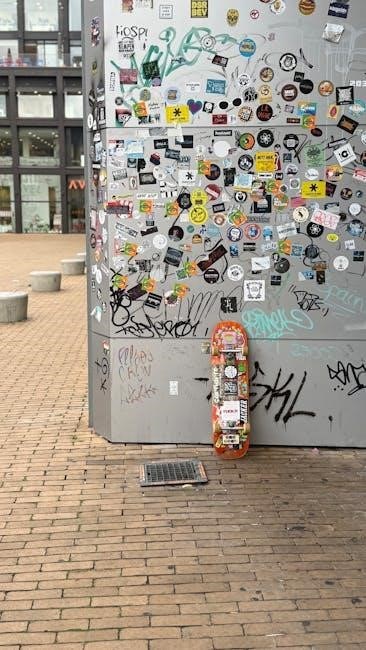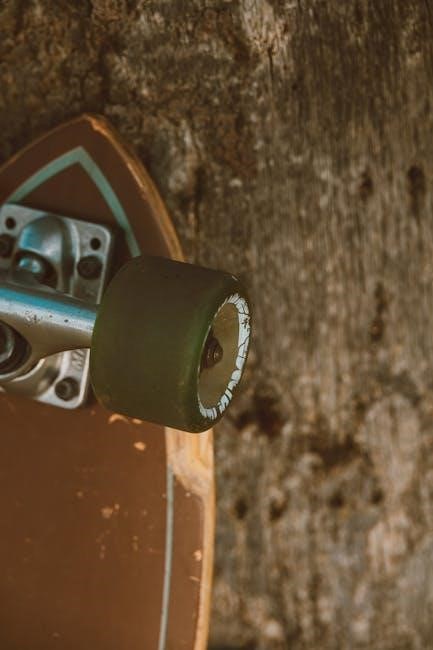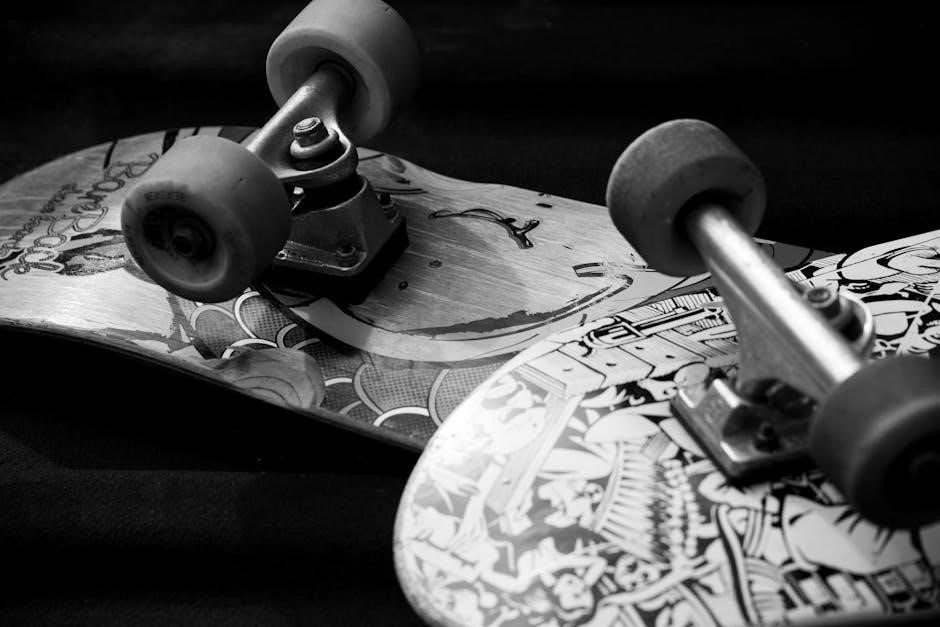
skateboard truck size guide
Skateboard trucks are essential components, connecting the deck to the wheels. Proper truck size ensures stability, maneuverability, and optimal performance. Understanding measurements and compatibility is key for a smooth ride.
Importance of Choosing the Right Truck Size
Choosing the right truck size is crucial for optimal skateboard performance and stability. Properly sized trucks ensure the deck aligns with the wheels, providing better control and maneuverability. Incorrect sizing can lead to poor fit, affecting how the board responds during tricks and cruising.
Trucks that are too wide or narrow for the deck can cause instability or limit turning ability. Matching truck size to deck width ensures compatibility and enhances overall skating experience. Additionally, the right truck size supports proper wheel fitment, reducing the risk of wheel bite and improving safety. Correct sizing also ensures the trucks’ height aligns with the wheels, maintaining optimal performance for various skating styles and tricks.

Understanding Truck Measurements
Truck measurements are critical for compatibility and performance. The axle width, hanger width, and truck height are key dimensions. Axle width ranges from 7.6 to 8.75 inches, determining stability and fit with the deck. Hanger width, the width of the truck’s hanger, affects maneuverability and should match the deck width closely. Truck height varies as low, medium, or high, influencing wheel size compatibility. Proper measurements ensure the trucks are neither too wide nor too narrow, balancing stability and agility. Understanding these dimensions helps skaters select the right trucks for their setup, enhancing overall skating experience and performance.

Factors to Consider When Selecting Truck Size
When selecting truck size, consider deck width, axle width, hanger width, and personal skating style. These factors influence stability, maneuverability, and overall skating performance and comfort.
Deck Width and Its Relation to Truck Size
Deck width is a critical factor in determining the appropriate truck size. Trucks should match the deck’s width to ensure proper fit and optimal performance. A deck that is too wide for the trucks can lead to instability, while a deck that is too narrow may result in poor maneuverability. Most skateboard trucks are designed to fit specific deck widths, with size charts providing guidance for compatibility. For example, a deck measuring 7.5 inches typically pairs with trucks that have a hanger width of 5 inches. Always refer to the manufacturer’s size guide to ensure the best fit for your setup.
Axle Width and Its Impact on Stability
Axle width plays a crucial role in determining the stability of a skateboard. Wider axles provide greater stability, making them ideal for cruising and downhill skating, while narrower axles offer more agility, suitable for street and technical skating. The axle width should align with the deck’s width to maintain balance and prevent uneven wear on the wheels. For instance, a deck measuring 8 inches typically pairs with an axle width of 8 inches. Proper axle width ensures even weight distribution, enhancing overall performance and ride quality. Always consult the manufacturer’s size chart to find the right axle width for your deck size and skating style.
Hanger Width and Its Role in Maneuverability
Hanger width significantly influences a skateboard’s maneuverability. A wider hanger offers more leverage, making turns easier and more responsive, which is beneficial for technical tricks. Conversely, a narrower hanger reduces weight and enhances agility, ideal for street skating. The hanger width should complement the deck size and personal skating style. For example, a 7.75-inch deck pairs well with a 5-inch hanger for balanced performance. Proper hanger width ensures smooth transitions and tighter turns, while incorrect sizing can lead to poor control. Always match hanger width to your deck and skating preferences to optimize maneuverability and overall skateboarding experience.
Personal Skating Style and Preferences
Your skating style and preferences play a crucial role in selecting the right truck size. Street skaters may prefer narrower trucks for lighter weight and quicker turns, while transition skaters benefit from wider trucks for stability at higher speeds. Cruisers might opt for medium-width trucks for a balanced feel. Consider your primary skating terrain; wider trucks excel on rough surfaces, while narrower trucks are better for technical tricks. Personal comfort and how the board feels underfoot are equally important. Matching your style with the appropriate truck size ensures a more enjoyable and responsive skating experience. Always align your truck choice with your skating goals and preferences for optimal performance and satisfaction.

Skateboard Truck Size Charts
Truck size charts provide specific measurements for brands like Independent, Thunder, and Venture. Sizes range from 129mm to 159mm, matching deck widths for optimal performance and stability.
Independent Truck Size Guide
Independent trucks offer a precise size guide to match deck widths. The 129mm truck fits decks 7.5–7.75″, while the 139mm suits 7.75–8.2″. Larger decks (8.25–8.75″) pair with 149mm trucks, and 159mm trucks fit decks 8.6–9.0″. This guide ensures optimal stability and maneuverability by aligning truck width with deck size, enhancing overall skateboarding performance and control. Proper sizing is crucial for a balanced setup, making Independent’s size chart a reliable tool for skaters seeking the perfect fit.
Thunder Truck Size Chart
Thunder trucks provide a detailed size chart to ensure compatibility with various deck widths. The 145mm model is ideal for decks measuring 7.75–8.2″, while the 147mm suits slightly wider decks at 8.0–8.25″. Thunder’s size options cater to different skating styles, offering precise fitment for enhanced stability and maneuverability. By aligning truck size with deck width, skaters can achieve optimal performance, making Thunder’s chart a valuable resource for selecting the right setup. This guide helps skaters avoid common mistakes like mismatched sizes, ensuring a responsive and balanced ride.

Venture Truck Size Guide
Venture Trucks offers a size guide to help skaters find the perfect fit for their decks. The 5.0 model suits decks up to 7.75″, while the 5.2 is designed for decks ranging from 7.8″ to 8.25″. Each size ensures compatibility and optimal performance, providing stability and responsiveness. Venture’s guide emphasizes matching truck width to deck size, avoiding common issues like improper fitment. This ensures a smooth, balanced ride, catering to various skating styles. By following the chart, skaters can enhance their setup’s efficiency and enjoy a more controlled skating experience.
Ace Truck Size Chart
Ace Trucks provides a detailed size chart to match deck widths with appropriate truck sizes. Their AF1 and Classic models cater to various deck dimensions, ensuring compatibility and performance. For instance, the AF1 5.0 fits decks 7.5″ to 7.75″, while the Classic 5.25 suits decks up to 8.25″. Each size is designed to optimize stability and maneuverability, offering a responsive ride. Skaters can refer to Ace’s chart to find the perfect fit, enhancing their skating experience with balanced and efficient setups tailored to their style.
Krux Truck Size Guide
Krux Trucks offers a straightforward size guide to help skaters choose the right trucks for their decks. Their chart includes hanger widths ranging from 7.6″ to 8.25″, each corresponding to specific deck widths. For example, the 7.6″ hanger width suits decks between 7.4″ and 7.6″, while the 8.25″ fits decks up to 8.75″. Krux emphasizes compatibility to ensure optimal performance, stability, and maneuverability. By following their guide, skaters can pair their deck with the appropriate truck size, enhancing their overall skating experience with a balanced and responsive setup tailored to their preferences and style.
How to Choose the Right Truck Size
Measure your deck width, match it to the truck size chart, and consider axle width and skating style to ensure optimal performance and stability for your setup.
Measuring Your Deck Width
Accurately measuring your skateboard deck width is crucial for selecting the right truck size. Place the deck on a flat surface and use a ruler or tape measure to find its width. Measure across the deck at its widest point, typically between the outer edges of the truck mounting holes. Record this measurement precisely, as it will guide your truck size selection. Most decks range from 7.5″ to 10″ in width, with trucks designed to match these dimensions. Ensuring your truck width aligns with your deck width is essential for proper fitment, stability, and performance. Double-check your measurements to avoid mismatches and ensure compatibility with other components.
Matching Deck Width to Truck Size
Matching your deck width to the appropriate truck size ensures optimal performance and stability. Skateboard trucks are designed to fit specific deck widths, with sizes ranging from 7.5″ to 10″. Use a truck size chart to align your deck width with compatible trucks. For example, a 7.5″ deck pairs with 7.6″ trucks, while an 8;0″ deck matches 8.0″ trucks. Proper alignment prevents the trucks from sticking out too far, which can cause instability, or being too narrow, limiting maneuverability. Ensure accuracy by referencing brand-specific charts, as some manufacturers may have slight variations in sizing. This precise pairing guarantees a smooth ride and enhances your skating experience by maintaining proper geometry and balance.
Understanding Axle Width Measurements
Axle width, measured as the distance between the two axles of a truck, plays a critical role in determining stability and maneuverability. Wider axles provide greater stability at higher speeds, while narrower axles allow for tighter turns and better responsiveness. Axle width is closely related to deck width, as wider decks require wider axles to maintain balance and prevent uneven stress on the trucks. Most trucks range from 7.5″ to 10″ in axle width, with standard sizes including 7.6″, 8.0″, and 8.25″. Choosing the correct axle width ensures your skateboard performs optimally for your skating style and deck size. Always reference brand-specific charts, as axle width measurements can vary slightly between manufacturers.
How to Measure Hanger Width

Measuring hanger width is a straightforward process that ensures compatibility between your trucks and deck. The hanger width is the distance from the inner edge of one hanger to the inner edge of the other. To measure accurately, place the truck on a flat surface and use a ruler or caliper to record the distance. Most trucks have hanger widths ranging from 5.0″ to 5.5″, with standard sizes including 5.0″, 5.25″, and 5.5″. Always refer to the manufacturer’s specifications, as slight variations may occur between brands. Proper hanger width aligns with deck width, ensuring even weight distribution and optimal performance. Accurate measurement is crucial for a balanced and responsive skateboard setup.

Compatibility with Other Skateboard Components
Truck size impacts compatibility with wheels, bearings, and deck width. Ensuring proper fitment enhances performance and durability, while incorrect sizing can lead to poor handling or equipment damage.
Truck Size and Wheel Compatibility
Truck size directly influences wheel compatibility, affecting both performance and safety. The truck’s height and axle width must align with the wheel size to ensure proper fitment and functionality. Lower trucks are ideal for smaller wheels (50-53mm), while higher trucks accommodate larger wheels (53mm+). Mismatching can lead to instability or reduced maneuverability. Always check compatibility charts to pair trucks with wheels correctly, ensuring optimal performance and preventing potential damage to the setup. Proper alignment enhances the overall skating experience, making it crucial for riders to consider these measurements when selecting components.
Truck Size and Deck Compatibility
Matching truck size to deck width is crucial for optimal performance and balance. Trucks that are too wide or too narrow can affect the skateboard’s stability and maneuverability. The axle width of the trucks should closely match the deck width to ensure even weight distribution and proper turning mechanics. For example, a deck measuring 7.5-7.75 inches pairs well with trucks having an axle width of 7.6 inches. Mismatched sizes can lead to a less responsive board or increased risk of damage. Always refer to size charts for specific brands like Independent, Thunder, or Ace to ensure compatibility, enhancing both the ride quality and overall skating experience.
Truck Size and Bearing Compatibility

Bearing compatibility with truck size is vital for smooth performance. Standard skateboard bearings, typically size 608, fit most trucks regardless of size. However, ensuring the bearings are properly seated and aligned within the truck’s axle is crucial. While bearing size remains consistent, the quality and fit can vary between brands. Always check compatibility with your specific truck brand and model. Properly maintained bearings enhance speed and maneuverability, making them a key component of your setup. Use the size charts provided by brands like Independent, Thunder, or Ace to confirm compatibility, ensuring optimal performance and a seamless skating experience.
Truck Profiles and Their Impact on Performance
Truck profiles affect stability and maneuverability. Lower trucks enhance stability, while higher trucks improve pop. Profile choice depends on skating style and preferred terrain or tricks.
Low Trucks vs. Medium Trucks
Low trucks and medium trucks differ in height, impacting performance. Low trucks offer stability, are closer to the ground, and ideal for technical tricks. Medium trucks provide better pop and versatility, suitable for street skating. Both options depend on personal style and skating terrain.
Medium Trucks vs. High Trucks
Medium trucks and high trucks differ primarily in ride height and performance. Medium trucks are lower, offering better stability and faster turning response, making them ideal for street skating. High trucks provide a taller profile, allowing for larger wheels and a smoother ride, often preferred for cruising or vert skating. The choice between them depends on skating style and terrain. Medium trucks suit most skaters, while high trucks are better for those prioritizing comfort and less concerned about stability. Both options are versatile but cater to different needs, ensuring optimal performance based on personal preference and skating goals.
How Truck Height Affects Wheel Size
Truck height significantly influences wheel size compatibility; Lower trucks work best with smaller wheels, typically 50-53mm, enhancing stability and maneuverability for street skating. Medium trucks pair well with 52-54mm wheels, offering a balanced ride. High trucks accommodate larger wheels, up to 53mm, ideal for cruising and maintaining speed. Proper alignment ensures wheels fit without biting the deck. Wheel size must match truck height to prevent performance issues. Choosing compatible sizes ensures optimal performance and a smooth skating experience.

Common Mistakes to Avoid

Common mistakes include choosing trucks too wide or narrow for the deck, ignoring personal skating style, and mismatching wheel sizes with truck heights, affecting performance.
Choosing Trucks Too Wide for the Deck
Choosing trucks too wide for the deck can negatively impact stability and maneuverability. Wider trucks may cause the skateboard to feel cumbersome, making it harder to turn or perform tricks; Additionally, overly wide trucks can lead to increased weight and reduced responsiveness, affecting overall performance. It’s crucial to match truck width to deck size for optimal balance and control. Consulting a size chart ensures proper fitment, preventing these issues. Personal skating style also plays a role, as wider trucks may suit certain riders but not others. Always measure carefully to avoid this common mistake, as it directly affects how the board handles and performs.
Selecting Trucks Too Narrow for the Deck
Selecting trucks too narrow for the deck can lead to instability and poor performance. Narrow trucks may cause the wheels to extend beyond the deck, resulting in uneven weight distribution and reduced control. This misalignment can make turning difficult and increase the risk of wheel bite, where the wheels rub against the deck during sharp turns. Additionally, narrow trucks may not provide sufficient stability, especially at higher speeds or when performing tricks. Using a truck size chart helps avoid this mistake, ensuring proper fitment and balance; Always double-check measurements to match truck width with deck size for optimal performance and safety. Proper alignment is crucial for a responsive and enjoyable skateboarding experience.
Ignoring Personal Skating Style
Ignoring personal skating style when choosing truck size can lead to a suboptimal setup. Different styles, such as cruising, street skating, or transition, require varying levels of stability and maneuverability. For example, street skaters may prefer narrower trucks for tighter turns and tricks, while cruiser riders might opt for wider trucks for stability. Failing to consider these preferences can result in a skateboard that doesn’t perform as expected. It’s essential to align truck size with skating style to ensure the best experience. Using a truck size guide tailored to individual needs helps achieve the perfect balance between performance and comfort, making every session more enjoyable and productive.
Advanced Tips for Customizing Truck Size
Customizing truck size involves mixing sizes for unique styles, adjusting tightness for performance, and upgrading to specialized trucks for specific tricks like grinds or transitions.
Mixing and Matching Truck Sizes
Mixing and matching truck sizes allows skaters to customize their setup for specific skating styles or tricks. For instance, using wider trucks in the rear for stability while narrower ones in the front enhance maneuverability. This setup is particularly beneficial for technical skating or street tricks. However, compatibility is crucial—ensure axle widths align with deck dimensions to maintain responsiveness and avoid uneven wear. Experimenting with different truck profiles, such as pairing low trucks with medium ones, can also optimize performance. Riders should consider personal preferences and skating terrain when blending sizes. Mixing brands may require adjustments, so it’s wise to start with similar sizes before exploring more varied combinations. This approach offers flexibility for advanced riders seeking tailored setups.
Adjusting Truck Tightness for Better Performance
Adjusting truck tightness is crucial for optimizing skateboard performance. Looser trucks enhance turning and maneuverability, ideal for technical tricks, while tighter trucks improve stability at higher speeds. Proper tightness balances responsiveness and control, reducing wheel bite and improving overall ride quality. Skaters should tighten trucks evenly to avoid uneven wear and ensure consistent performance. For street skating, slightly tighter trucks are preferred, whereas park skating may benefit from a looser setup. Experimentation is key to finding the perfect tightness for individual skating styles. Using the correct tools, like a T-tool or Allen wrench, ensures precise adjustments. Regularly checking and tightening trucks maintains optimal functionality and extends their lifespan.
Upgrading Trucks for Specific Tricks
Upgrading trucks for specific tricks enhances performance and adapts to skating needs. For technical tricks, lighter trucks improve maneuverability, while reinforced models boost durability. Street skaters may prefer wider hangers for grind stability. Vert skaters benefit from high trucks for transition control. Customizing truck components, like bushings and pivot cups, tailors handling and responsiveness. Tightening trucks minimizes wheel bite during flips. Experimenting with different setups ensures optimal performance for various techniques. Upgrading based on trick requirements helps skaters progress and master advanced maneuvers. Proper truck selection and customization are vital for achieving the desired trick execution and overall skating success.
Selecting the right skateboard truck size enhances performance and personal skating style. Proper measurements, compatibility, and customization ensure a smooth, enjoyable ride for all skill levels.
Final Thoughts on Selecting the Right Truck Size
Selecting the right truck size is crucial for optimal skateboarding performance. Ensure trucks match your deck width for stability and maneuverability. Consider personal skating style, whether cruising or tricks. Compatibility with wheels and bearings is also key. Experiment with different setups to find your perfect fit, enhancing your overall skating experience. Proper measurements and customization lead to better control and enjoyment. Always refer to size guides for top brands like Independent, Thunder, and Ace to make informed decisions. Remember, the right trucks can elevate your skills and make every ride more enjoyable.
Encouragement to Experiment and Find the Perfect Fit
Experimentation is key to finding the perfect truck setup. Don’t hesitate to try different sizes and configurations to suit your skating style. Whether you’re cruising or performing tricks, the right fit enhances performance and comfort. Mix and match components, adjust tightness, and explore various truck profiles to discover what works best for you. Remember, there’s no one-size-fits-all solution. Take your time, stay patient, and embrace the process of customization; The ideal setup will boost your confidence and elevate your skateboarding experience, making every ride more enjoyable and tailored to your unique preferences.